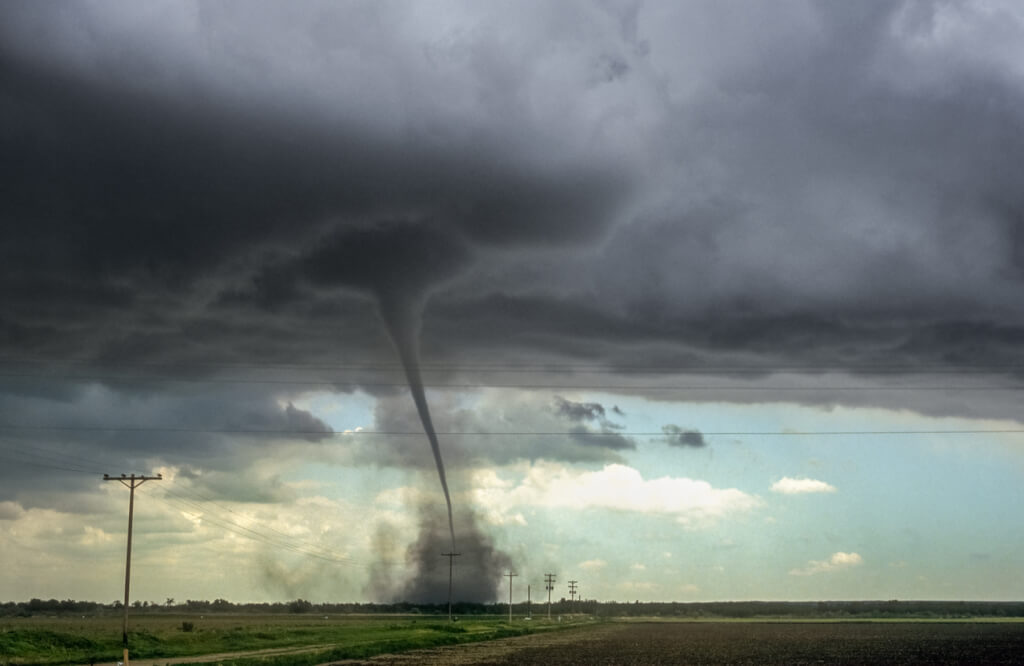A matter of life and death: how to survive during a tornado
Over the past week, the United States has been hit by several series of tornadoes: more than 60 people died. Forecasters predict that tornadoes will continue. How to protect yourself and your loved ones from mortal danger WikiHow.

Photo: IStock
Tornadoes are often said to be the most violent storms in nature, and for good reason. Not only do tornadoes carry winds up to 480 km/h (25 km/h)—winds that can flatten buildings and lift cars XNUMX meters or more—they are also often accompanied by lightning, heavy rains, flash floods, and hail. When a tornado strikes, your every action can mean a choice between life and death.
Building survival
1. If possible, immediately move to the underground shelter. At the first sign of a tornado, or if a tornado warning has been issued, stop whatever you are doing and seek suitable shelter immediately, even if you do not see a tornado. A warning means a tornado has been detected by radar.
An underground tornado shelter or a specially designed tornado safe room is the safest place to be during a storm. Some homes, businesses, and schools in tornado-prone areas have such shelters.
If the tornado shelter is not available, go to the basement of the building. Stay away from windows and cover yourself with a mattress, pillows, or sleeping bags. If possible, get under a heavy table to protect you from falling debris.
2. Stay in a windowless room on the lowest level if you can't go underground. In a building without a basement, avoid the windows and go to the lowest floor. Alternatively, seek shelter in a small room near the center of the house, under a stairwell, or in a windowless interior hallway. No matter where you are, squat low to the ground or lie face down and cover your head with your hands. If possible, hide under a sturdy table and cover yourself with a mattress, pillows, or blankets.
On the subject: Dangerous constructions: 10 states of America with the most unreliable bridges
Bathrooms can be especially effective because they are reinforced with pipes and you can lie in the tub.
Stay away from elevators as you can get stuck in them if the power goes out. Instead, use the stairs to get down to the lowest floor.
3. Know where to look for cover. The following locations can be severely damaged by strong winds:
- Mobile homes.
- High buildings.
- Open rooms with lots of windows.
- Buildings with flat, wide roofs (canteens, gyms, etc.).
4. Stay in your shelter until the danger of the tornado has passed. If possible, listen to the advice of the National Weather Service. Be aware that multiple tornadoes often form in the same area, and it may not be safe to leave the shelter even after one tornado has passed.
Even if the tornado has passed, you should still use common sense. If the surrounding area looks dangerous, it may be safer to stay in the shelter.
5. Cautiously leave the shelter. Use caution when driving through tornado-affected areas. After being hit by a tornado, you are likely to face hazards such as flooding, falling debris, collapsing buildings, and blocked roads. Be vigilant and proceed with caution, as sharp objects may be scattered on the ground.
Avoid fallen power lines and puddles with wires in them, and do not use matches or lighters in case of a natural gas or fuel tank leak.
Under no circumstances enter damaged buildings as they may collapse.
outdoor survival
1. Notice the outward signs of potential tornadoes that are coming. Being able to quickly determine your risk is one of the key steps to finding shelter and surviving. There are several proven ways to stay safe outdoors if you get caught in a tornado, and the number one tip is to find shelter.
Most tornadoes are accompanied by thunderstorms, hail and of course strong winds, but there are other things to watch out for:
- Dark clouds with a greenish tint.
- A loud roar that is similar to the sound of an airplane taking off.
- "Cloud Walls" when the base of a thundercloud appears to be descending.
- Funnels or swirling clouds.
- "Wall" of debris and dust.
2. If possible, then you need to get to the nearest shelter. If you hear a warning but it's still safe to drive, fasten your seat belt and take a route through less open terrain as soon as possible. Turn on the high beam and immediately move to some building, preferably with a basement. You will almost always be safer in a building than in a car.
3. If you see a tornado and/or flying debris making driving dangerous, stay where you are.
If your car is littered with debris while driving, this is a signal to stop.
Never try to outrun a tornado in an urban environment - instead, it is better to get to any building for shelter.
Stay in your vehicle unless there are absolutely no other structures nearby. Fasten your seat belt and crouch below the window line. Take your coat, blanket, pillow, etc. and drape them over your head and back and keep your arms above your head to protect your skull.
Like the article? Support ForumDaily!?
Stay where you are until you can safely drive to the hideout. Again, there may be several tornadoes after the first one has passed.
4. Find a low point relative to your current position if the tornado caught you completely out in the open. If there is a low moat nearby and you have no other options, jump into it. Lie face down and cover the back of your head with your hands.
If you can, cover your entire body with a blanket or similar covering to prevent scratches from debris.
5. Stay away from overpasses, bridges or areas with a lot of debris. Falling and rotating debris is responsible for the majority of tornado deaths. If you can't decide between a flyover or an open space, choose an open space and try to get as low as you can.
6. Move perpendicular to the direction of the tornado if you are in open water. Waterspouts, tornadoes that form above water, present a particular problem. Although they are generally weaker and slower than tornadoes on land, shelter is not possible in open water. If waterspouts have been seen in the area, get out of the water if possible. If you are in the water when a waterspout hits you, experts recommend trying to avoid it by swimming at right angles to its path rather than directly away from it.
If a waterspout is about to hit the boat, it's probably best to dive overboard, as then you'll have a better chance of avoiding injury from flying debris.
If you are on land and the tornado is very close to the shore, you are not necessarily safe. Although they rarely go to land, they can. Treat them like any other tornado and hide in case they make landfall.
Preparing for a tornado
1. Watching a tornado means there is a tornado threat in your area and you should be on the lookout for the news. The tornado warning is much more severe. Tornado warnings mean that a sign of danger has been detected and that you should take immediate action depending on the location of the tornado and its predicted path.
Whenever you see reports of tornadoes, try to stay tuned for further news. Whenever you see a tornado warning, take cover immediately.
2. Create an emergency plan for your home. Make a plan for where to go during a tornado. Keep this plan ready and practice before you need it. Everyone you live with needs to know exactly which room to go to in the event of a tornado. Make sure this room has everything you need.
- Pay attention to places in each room where you should seek cover, such as under tables or cabinets.
- Are there places where you could be trapped or in particular danger, such as rooms upstairs? Are there ways to keep them safe, like hiding a cheap rope ladder?
- Do you have first aid kits, crowbars, fire extinguishers, or other special equipment at home that people need to know how to find?
3. Assemble a tornado emergency kit. Hide the kit in your safe room. It should contain everything you need to survive in the worst case scenario and can be used as a general emergency kit for most natural disasters.
First aid
- Gauze, antibiotic wipes, painkillers, bandages, broad-spectrum antibiotic, prescriptions needed, band-aids, diarrhea medicine, bar of soap.
Food and water
- 4 liters for each person in the house, canned food, cracker bags and other non-perishable foods.
Other
- Scissors, writing utensils, flashlights, battery-powered radio, spare batteries, penknife, plastic bags, needle and thread.
4. Learn how to turn off the gas in your home. Major disasters can destroy gas pipes and lead to incredibly dangerous leaks. If you smell gas, you should be able to turn it off immediately. Call your gas supplier if you have any questions.
5. Clear your lawn of potentially dangerous debris. Keeping your lawn clean is about more than appearance. Dry branches, decorations and garden chairs will be carried at hundreds of kilometers per hour in the event of a tornado, which can turn into a serious danger. To protect your property during a tornado, take the following precautions:
- Cut off dead or damaged tree limbs that can be blown off by strong winds.
- Tie or secure garden furniture. If you can't do this, consider moving heavier items indoors, but only if you have the time.
- Make sure that there is nothing on the lawn that can turn into a weapon when it is picked up by a tornado, such as glass balls.
6. Consider building a tornado shelter. This is very reasonable if you live in a high-risk area. If tornadoes are a regular occurrence in your area, buying or building a shelter will pay off. The Federal Emergency Management Agency (FEMA) has also prepared guidelines for self-constructing a shelter.
Read also on ForumDaily:
What not to be afraid of in the USA: advice to new immigrants
Subscribe to ForumDaily on Google NewsDo you want more important and interesting news about life in the USA and immigration to America? — support us donate! Also subscribe to our page Facebook. Select the “Priority in display” option and read us first. Also, don't forget to subscribe to our РєР ° РЅР ° Р »РІ Telegram and Instagram- there is a lot of interesting things there. And join thousands of readers ForumDaily New York — there you will find a lot of interesting and positive information about life in the metropolis.
-
Pros and cons of political asylum in the United States12868
-
Breathtaking: Must-Have Places in Southern California467
-
Top 15 most breathtaking caves in the world265
-
17 amazing things people decide to get a job0
-
A company in the USA will help everyone with paying rent in order to save them from fines0
-
Pros and cons of political asylum in the United States12868
-
Five dangerous mistakes when applying for a green card due to marriage4147
-
15 amazing professions you might not know about1313
-
A way to save in Target, which many do not know1034
-
What you need to know before you go on your first cruise812
-
Breathtaking: Must-Have Places in Southern California467
-
How to Fly Free: 10 Tips385
-
Pros and cons of political asylum in the United States12868
-
Personal experience: who and why you should not move to the USA5614
-
Where in the USA to buy the medicines we are used to: a list of pharmacies5330
-
How to hit the jackpot: tips from a man who won the lottery 7 times4898
-
50 diseases whose presence will increase the cost of health insurance in the USA4329
-
Five dangerous mistakes when applying for a green card due to marriage4147
-
Street, avenue, boulevard or drive: how to understand the classification of US streets and roads1461











